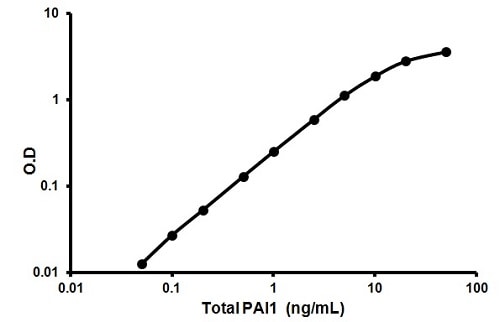Mouse PAI1 Total ELISA Kit (ab157529)
Key features and details
- Sensitivity: 0.006 ng/ml
- Range: 0.05 ng/ml - 50 ng/ml
- Sample type: Plasma, Serum
- Detection method: Colorimetric
- Assay type: Sandwich (quantitative)
- Reacts with: Mouse, Rabbit
Overview
-
Product name
Mouse PAI1 Total ELISA Kit
See all PAI1 kits -
Detection method
Colorimetric -
Precision
Intra-assay Sample n Mean SD CV% 1 20 0.288ng/ml 0.023 7.9% 2 20 1.64ng/ml 0.081 4.92% 3 20 20.8ng/ml 1.86 8.95% Inter-assay Sample n Mean SD CV% 1 10 0.307ng/ml 0.04 12.9% 2 10 1.46ng/ml 0.155 10.6% 3 10 16.6ng/ml 2.41 14.6% -
Sample type
Serum, Plasma -
Assay type
Sandwich (quantitative) -
Sensitivity
0.006 ng/ml -
Range
0.05 ng/ml - 50 ng/ml -
Recovery
100.8 %
Sample specific recovery Sample type Average % Range Plasma 100.8 89.1% - 112% -
Assay time
1h 50m -
Assay duration
Multiple steps standard assay -
Species reactivity
Reacts with: Mouse, Rabbit -
Product overview
Abcam’s Total PAI1 ELISA (Enzyme-Linked Immunosorbent Assay) kit is designed for is for the quantitative determination of active plasminogen activator inhibitor type 1 in mouse plasma.
Mouse PAI1 present in plasma reacts with the capture antibody coated and dried on a microtiter plate. Free, latent and complexed PAI1 will bind to the plate. Any unbound PAI1 is washed away and an anti-PAI1 primary antibody is added. Excess primary antibody is washed away and bound antibody, which is proportional to the total PAI1 present in the samples, is then reacted with the secondary antibody. Following an additional washing step, TMB is then used for color development at 450nm. The amount of color development is directly proportional to the concentration of total PAI1 in the sample.
-
Platform
Microplate
Properties
-
Storage instructions
Store at +4°C. Please refer to protocols. -
Components 1 x 96 tests 10X Wash Buffer 1 x 50ml Anti-mouse PAI1 coated Microtiter Plate 1 unit Anti-mouse PAI1 Primary Antibody 1 vial Anti-rabbit horseradish peroxidase secondary antibody 1 x 10µl Mouse PAI1 Standard 1 vial TMB Substrate Solution 1 x 10ml -
Research areas
-
Function
This inhibitor acts as 'bait' for tissue plasminogen activator, urokinase, and protein C. Its rapid interaction with TPA may function as a major control point in the regulation of fibrinolysis. -
Tissue specificity
Found in plasma and platelets and in endothelial, hepatoma and fibrosarcoma cells. -
Involvement in disease
Defects in SERPINE1 are the cause of plasminogen activator inhibitor-1 deficiency (PAI-1D) [MIM:613329]. It is a hematologic disorder characterized by increased bleeding after trauma, injury, or surgery. Affected females have menorrhagia. The bleeding defect is due to increased fibrinolysis of fibrin blood clots due to deficiency of plasminogen activator inhibitor-1, which inhibits tissue and urinary activators of plasminogen.
Note=High concentrations of SERPINE1 seem to contribute to the development of venous but not arterial occlusions. -
Sequence similarities
Belongs to the serpin family. -
Post-translational
modificationsInactivated by proteolytic attack of the urokinase-type (u-PA) and the tissue-type (TPA), cleaving the 369-Arg-
-Met-370 bond. -
Cellular localization
Secreted. - Information by UniProt
-
Alternative names
- Clade E
- Endothelial plasminogen activator inhibitor
- Nexin
see all -
Database links
- Entrez Gene: 18787 Mouse
- SwissProt: P22777 Mouse
- Unigene: 250422 Mouse











